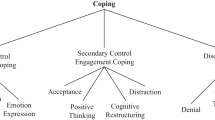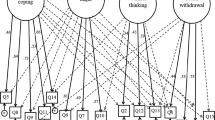Abstract
The extent to which measures of coping adequately capture the ways that homeless youth cope with challenges, and the influence these coping styles have on mental health outcomes, is largely absent from the literature. This study tests the factor structure of the Coping Scale using Exploratory Factor Analysis (EFA) and then investigates the relationship between coping styles and depression using hierarchical logistic regression with data from 201 homeless youth. Results of the EFA indicate a 3-factor structure of coping, which includes active, avoidant, and social coping styles. Results of the hierarchical logistic regression show that homeless youth who engage in greater avoidant coping are at increased risk of meeting criteria for major depressive disorder. Findings provide insight into the utility of a preliminary tool for assessing homeless youths’ coping styles. Such assessment may identify malleable risk factors that could be addressed by service providers to help prevent mental health problems.
Similar content being viewed by others
References
Alder, C. (1991). Victims of violence: The case of homeless youth. Australian & New Zealand Journal of Criminology, 24(1), 1–14.
American Psychiatric Association. (2000). Diagnostic and statistical manual of mental disorders (4th ed., Text Revision). Washington, DC: American Psychiatric Association.
Bender, K. A., Ferguson, K., Thompson, S., Komlo, C., & Pollio, D. (2010). Factors associated with trauma and posttraumatic stress disorder among homeless youth in three US cities: The importance of transience. Journal of Traumatic Stress, 23(1), 161–168.
Boals, A., vanDellen, M. R., & Banks, J. B. (2011). The relationship between self-control and health: The mediating effect of avoidant coping. Psychology and Health, 26, 1049–1062. doi:10.1080/08870446.2010.529139.
Carver, C. S. (1997). You want to measure coping but your protocol’s too long: Consider the brief COPE. International Journal of Behavioral Medicine, 4, 92–100.
Cauce, A. M., Paradise, M., Ginzler, J. A., Embry, L., Morgan, C. J., Lohr, Y., et al. (2000). The characteristics and mental health of homeless adolescents: Age and gender differences. Journal of Emotional and Behavioral Disorders, 8(4), 230–239. doi:10.1177/106342660000800403.
Chao, R. C. L. (2011). Managing stress and maintaining well-being: Social support, problem-focused coping, and avoidant coping. Journal of Counseling & Development, 89, 338–348.
Coates, J., & McKenzie-Mohr, S. (2010). Out of the frying pan, into the fire: Trauma in the lives of homeless youth prior to and during homelessness. Journal of Sociology & Social Welfare, 37, 65–96.
Compas, B. E., Connor-Smith, J. K., Saltzman, H., Thomsen, A. H., & Wadsworth, M. E. (2001). Coping with stress during childhood and adolescence: Problems, progress, and potential in theory and research. Psychological Bulletin, 127, 87–127. doi:10.1037//0033-2909.127.1.87.
Comrey, A. L., & Lee, H. B. (1992). A first course in factor analysis. Hillsdale, NJ: Erlbaum.
Curry, S. L., & Russ, S. W. (1985). Identifying coping strategies in children. Journal of Clinical Child Psychology, 14, 61–69.
DeVellis, R. F. (1991). Scale development: Theory & applications. Newbury Park, CA: Sage.
Ebata, A. T., & Moos, R. H. (1991). Coping and adjustment in distressed and healthy adolescents. Journal of Applied Developmental Psychology, 17, 33–54.
Ensign, J., & Santelli, J. (1998). Health status and service use: Comparison of adolescents at a school-based health clinic with homeless adolescents. Archives of Pediatrics and Adolescent Medicine, 152(1), 20–24.
Ferguson, K. M., Bender, K. A., Thompson, S. J., Xie, B., & Pollio, D. (2012). Exploration of arrest activity among homeless young adults in four US cities. Social Work Research, 36(3), 233–238.
Folkman, S., & Lazarus, R. S. (1985). If it changes it must be a process: Study of emotion and coping during three stages of a college examination. Journal of Personality and Social Psychology, 48, 150–170.
Folkman, S., & Lazarus, R. S. (1988). Ways of coping questionnaire. Redwood City, CA: Mind Garden.
Grant, K. E., Compas, B. E., Stuhlmacher, A. F., Thurm, A., McMahon, S. D., & Halpert, S. (2003). Stressors and child and adolescent psychopathology: Moving from markers to mechanisms of risk. Psychological Bulletin, 129, 447–466. doi:10.1037/0033-2909.129.3.447.
Guada, J., Land, H., & Han, J. (2011). An exploratory factor analysis of the burden assessment scale with a sample of African-American families. Community Mental Health Journal, 47, 233–242. doi:10.1007/s10597-010-9298-0.
Herman-Stahl, M. A., Stemmler, M., & Petersen, A. C. (1994). Approach and avoidant coping: Implications for adolescent mental health. Journal of Youth and Adolescence, 24, 649–665.
Kidd, S. A. (2003). Street youth: Coping and interventions. Child and Adolescent Social Work Journal, 20(4), 235–261. doi:10.1023/A:1024552808179.
Kidd, S. A., & Carroll, M. R. (2007). Coping and suicidality among homeless youth. Journal of Adolescence, 30, 283–296. doi:10.1016/j.adolescence.2006.03.002.
Kipke, M. D., Simon, T. R., Montgomery, S. B., Unger, J. B., & Iversen, E. F. (1997). Homeless youth and their exposure to and involvement in violence while living on the streets. Journal of Adolescent Health, 20(5), 360–367.
Lazarus, R. S., & Folkman, S. (1984). Stress, appraisal, and coping. New York, NY: Springer.
Lecrubier, Y., Sheehan, D., Weiller, E., Amorim, P., Bonora, I., Sheehan, K., et al. (1997). The MINI International Neuropsychiatric Interivew. A short diagnostic structured interview: Reliability and validity according to the CIDI. European Psychiatry, 12, 224–231.
Ledesma, R. D., & Valero-Mora, P. (2007). Determining the number of factors to retain in EFA: An easy-to-use computer program for carrying out parallel analysis. http://pareonline.net/pdf/v12n2.pdf.
Lindsay, E. W., Kurtz, D., Jarvis, S., Williams, N. R., & Nackerud, L. (2000). How run-aways and homeless youth navigate troubled waters: Personal strengths and resources. Child and Adolescent Social Work Journal, 17, 115–140.
Mayordomo-Rodríguez, T., Meléndez-Moral, J. C., Viguer-Segui, P., & Sales-Galán, A. (2014). Coping strategies as predictors of well-being in youth adult. Social Indicators Research. doi:10.1007/s11205-014-0689-4.
Melander, L. A., & Tyler, K. A. (2010). The effect of early maltreatment, victimization, and partner violence on HIV risk behavior among homeless young adults. Journal of Adolescent Health, 47(6), 575–581.
Nielsen, M. B., & Knardahl, S. (2014). Coping strategies: A prospective study of patterns, stability, and relationships with psychological distress. Scandinavian Journal of Psychology, 55(2), 142–150.
Pina, A. A., Villalta, I. K., Ortiz, C. D., Gottschall, A. C., Costa, N. M., & Weems, C. F. (2008). Social support, discrimination, and coping as predictors of posttraumatic stress reactions in youth survivors of Hurricane Katrina. Journal of Clinical Child & Adolescent Psychiatry, 37(3), 564–574. doi:10.1080/15374410802148228.
Rosenthal, D., Mallett, S., & Myers, P. (2007). Why do homeless young people leave home? Australian and New Zealand Journal of Public Health, 30(3), 281–285. doi:10.1111/j.1467-842X.2006.tb00872.x.
Rytwinski, N. K., Avena, J. S., Echiverri-Cohen, A. M., Zoellner, L. A., & Feeny, N. C. (2013). The relationships between posttraumatic stress disorder severity, depression severity and physical health. Journal of Health Psychology, 19(4), 509–520.
Saha, R., Huebner, S., Hills, K. J., Malone, P. S., & Valois, R. F. (2014). Social coping and life satisfaction in adolescents. Social Indicators Research, 115, 241–252. doi: 10.1007/s11205-012-0217-3
Sheehan, D., Lecrubier, Y., Sheehan, K., Amorim, P., Janavs, J., Weiller, E., et al. (1998). The Mini-International Neuropsychiatric Interview (MINI): The development and validation of a structured diagnostic psychiatric interview for DSM-IV and ICD-10. Journal of Clinical Psychiatry, 59, 22–33.
Skinner, E. A., Edge, K., Altman, J., & Sherwood, H. (2003). Searching for the structure of coping: A review and critique of category systems for classifying ways of coping. Psychological Bulletin, 129, 216–269. doi:10.1037/0022-2909.129.2.216.
Stewart, M., Reutter, L., Letourneau, N., & Makwarimba, E. (2009). A support intervention to promote health and coping among homeless youths. Canadian Journal of Nursing Research, 41, 51–77.
Thompson, S. J., Pollio, D. E., & Bitner, L. (2000). Outcomes for adolescents using runaway and homeless youth services. Journal of Human Behavior in the Social Environment, 3, 79–97. doi:10.1300/J137v03n01_05.
Unger, J. B., Kipke, M. D., Simon, T. R., Johnson, C. J., Montgomery, S. B., & Iverson, E. (1998). Stress, coping, and social support among homeless youth, 13(2), 134–157. doi:10.1177/0743554898132003.
Votta, E., & Manion, I. G. (2003). Factors in the psychological adjustment of homeless adolescent males: The role of coping style. Journal of the American Academy of Child and Adolescent Psychiatry, 42(7), 778–785. doi:10.1097/01.CHI.0000046871.56865.D9.
Whitbeck, L. B. (2009). Mental health and emerging adulthood among homeless young people. New York, NY: Taylor & Francis Group.
Whitbeck, L. B., Hoyt, D. R., & Ackley, K. A. (1997). Abusive family backgrounds and later victimization among runaway and homeless adolescents. Journal of Research on Adolescence, 7(4), 375–392.
Whitbeck, L. B., Hoyt, D. R., & Yoder, K. A. (1999). A risk-amplification model of victimization and depressive symptoms among runaway and homeless adolescents. American Journal of Community Psychology, 27(2), 273–296.
Wilkinson, R. B., Walford, W. A., & Espnes, G. A. (2000). Coping styles and psychological health in adolescents and young adults: A comparison of moderator and main effects models. Australian Journal of Psychology, 52, 155–162.
Conflict of interest
The authors declare that they have no conflict of interest.
Compliance with Ethical Standards
All procedures performed in studies involving human participants were in accordance with the ethical standards of the institutional and/or national research committee with the 1964 Helsinki declaration and its later amendments or comparable ethical standards.
Human and Animal Rights
This article does not contain any studies with animals performed by any of the authors.
Informed Consent
Informed consent was obtained from all individual participants included in the study.
Author information
Authors and Affiliations
Corresponding author
Additional information
The project was approved by the researchers’ university Institutional Review Board.
Rights and permissions
About this article
Cite this article
Brown, S.M., Begun, S., Bender, K. et al. An Exploratory Factor Analysis of Coping Styles and Relationship to Depression Among a Sample of Homeless Youth. Community Ment Health J 51, 818–827 (2015). https://doi.org/10.1007/s10597-015-9870-8
Received:
Accepted:
Published:
Issue Date:
DOI: https://doi.org/10.1007/s10597-015-9870-8




